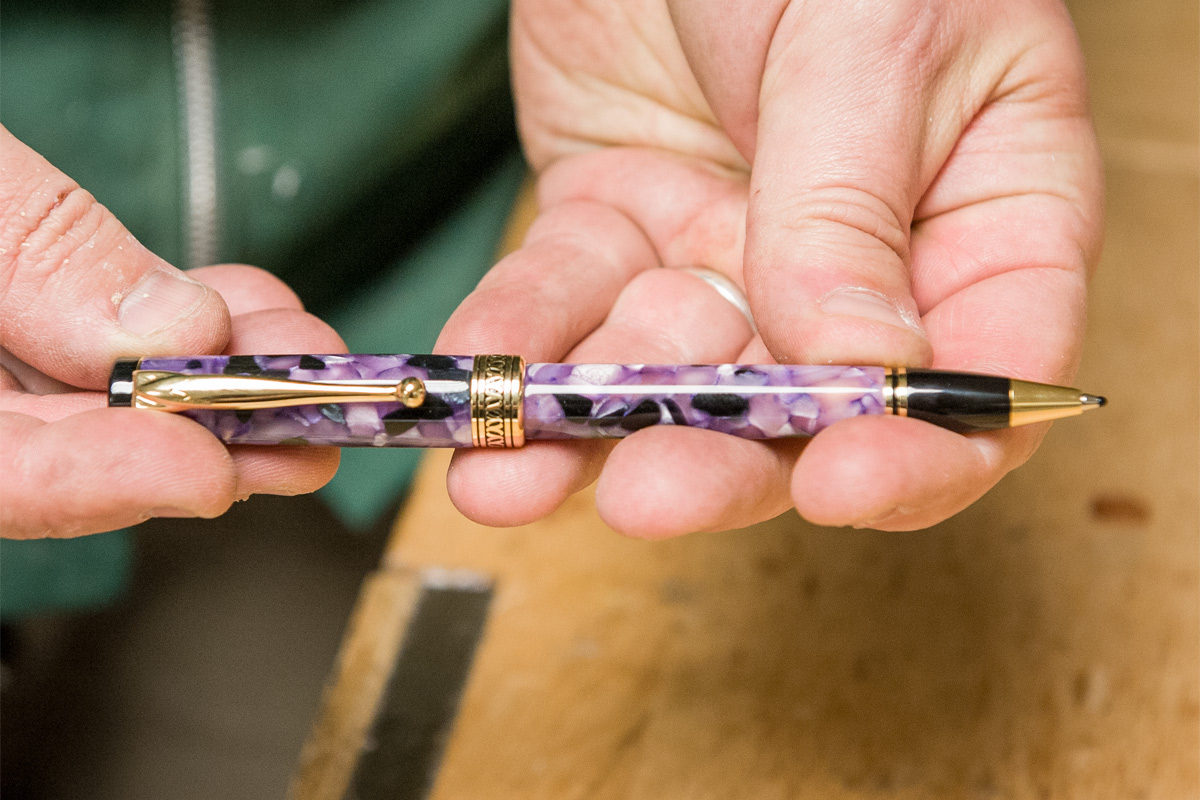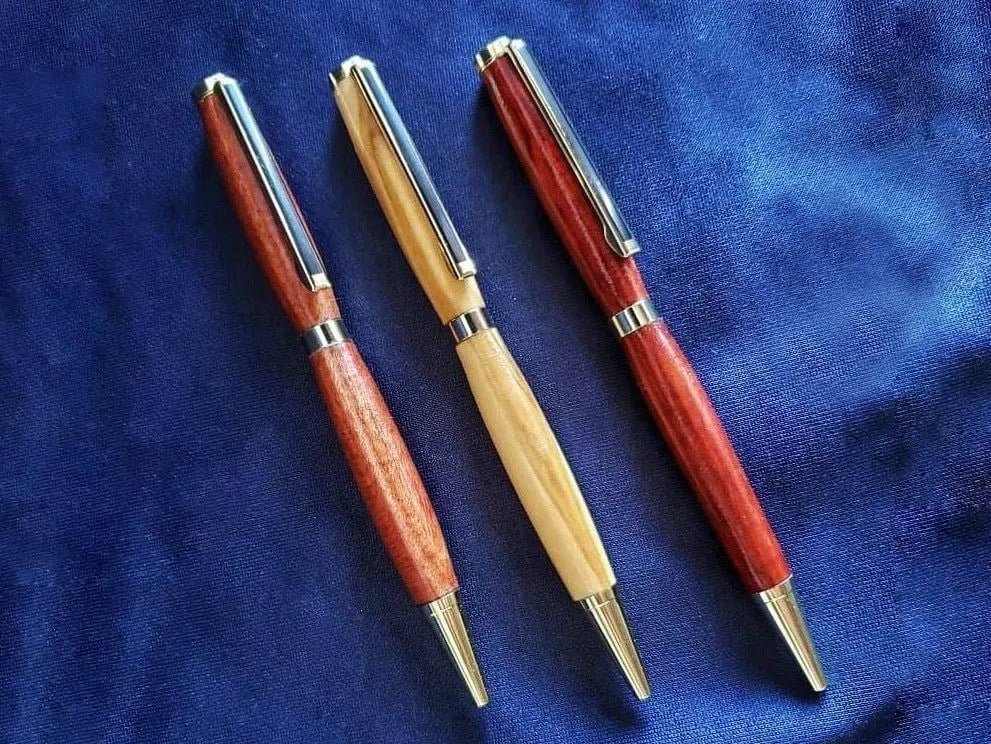Table of Contents
Turning pens involves crafting custom writing instruments from wood, acrylic, or other materials. It requires precision, creativity, and skill.
Turning pens is a fascinating hobby that blends artistry and craftsmanship. It begins with selecting the right material, such as exotic wood or colorful acrylic, which provides the pen with its unique look. The process involves shaping the material on a lathe, sanding it to a smooth finish, and finally assembling the pen components.
Each step demands attention to detail and precision to ensure a functional and attractive final product. This hobby not only offers a creative outlet but also results in beautiful, personalized writing instruments that can be used daily or gifted to others.
The Renaissance Of Handcrafted Pens
Handcrafted pens are making a big comeback. People love the unique designs. Each pen feels special. They enjoy the personal touch. These pens are not mass-produced. They are made by skilled artisans. This adds to their charm. Digital tools can’t replace this feeling. Writing with a handcrafted pen is a joy. It connects you to the past. It feels more thoughtful and meaningful.
Quality matters more than quantity. A good pen lasts longer. It writes better. The materials are superior. Each pen is crafted with care. Mass-produced pens can’t compare. They often break or run out of ink quickly. A handcrafted pen is a good investment. It becomes a cherished item. You can pass it down to future generations.
Essential Tools And Materials
Choosing the best wood or resin is crucial. Hardwoods like maple or walnut are great. Resin can be colorful and unique. Make sure the material is dry and stable. This ensures a smooth and beautiful pen.
A good lathe is a must for pen turning. It helps shape the wood or resin. Mini lathes are perfect for beginners. They are compact and easy to use. Ensure the lathe has variable speed settings. This helps in controlling the cutting speed.
Precision tools make your work easier. Chisels and gouges are essential. They help in shaping and detailing. Calipers measure the thickness accurately. Sandpaper smooths the pen surface. Use different grits for a fine finish.
Mastering The Craft
Starting with simple designs helps. Basic techniques involve using a lathe and gouges. Make sure the wood is securely mounted. Always wear safety gear. Practice makes perfect, so turn often. Watch video tutorials for tips. Join a local turning club. Learn from experienced turners. Always work in a clean environment. Keep tools sharp and ready.
Once basics are mastered, move to advanced skills. Try creating intricate patterns. Experiment with different wood types. Use texturing tools for unique effects. Practice with segmented turning. Learn how to fix mistakes. Understand wood grain direction. Work on developing a steady hand. Study advanced turning books. Attend workshops for hands-on experience.
Finishing is crucial for a polished look. Sand the pen smoothly in steps. Start with coarse grit, move to fine grit. Apply sealer to protect the wood. Use polish for a shiny finish. Consider using CA glue for durability. Buff the pen with a soft cloth. Ensure even application of finishes. Allow time for drying between coats. Test finishes on scrap wood first.
Design That Speaks Volumes
Great pen designs blend beauty and functionality. Every curve and line has a purpose. The pen must feel good in your hand. It should also be easy to use. A well-designed pen makes writing a pleasure. The looks should match its function. Quality materials ensure durability.
Many clients love customized pens. Personal touches make them special. You can choose the color, material, and design. Some may want their name on the pen. Others may prefer unique patterns. Custom pens often become cherished items. They make great gifts for any occasion.
Branding Your Artisan Pen Business
Elevate your artisan pen business by highlighting the craftsmanship behind each unique turning pen. Showcase the intricate designs and quality materials that set your pens apart from mass-produced options.
Creating A Compelling Brand Story
Your brand story should be unique. Share why you started making pens. Explain what makes your pens special. This can build a connection with your customers. Use simple, clear words. Your story should be easy to remember. Highlight your passion for craftsmanship. Show your commitment to quality.
Logo And Packaging Design
A logo represents your brand. It should be simple and memorable. Choose colors that reflect your brand’s personality. Packaging is also important. It protects the pen and adds to the experience. Use eco-friendly materials. Add a personal touch, like a handwritten note. This shows you care about your customers.

Credit: sw-sw.org
Effective Marketing Strategies
Social media is powerful. It helps you reach a wide audience. Create engaging posts about your pens. Share photos and videos. Use hashtags to increase visibility. Respond to comments quickly. Run contests and giveaways. Collaborate with influencers. This builds trust and interest.
Attend craft fairs and pen shows. These events attract pen lovers. Set up an attractive booth. Display your best pens. Offer live demonstrations. People love to see the process. Have business cards ready. Build relationships with visitors. Collect contact information for follow-ups.
An online store is crucial. It makes buying easy for customers. Choose a user-friendly platform. Add high-quality images of your pens. Write clear descriptions. Offer various payment options. Provide excellent customer service. Ensure a smooth checkout process. Update your inventory regularly.
Pricing Your Creations
Pricing your turned pens requires a balance between material costs, craftsmanship, and market demand. Highlight the uniqueness and quality of your creations to justify your price.
Cost Analysis For Profitability
Calculating costs is crucial for profitability. First, add up all material costs. Include wood, pen kits, and finishes. Don’t forget about consumables like sandpaper and glue. Next, account for your time. Determine an hourly rate for your work. Multiply this rate by the hours spent on each pen. Add these two figures together to get the total cost. This will help in setting a profitable price.
Competitive Pricing In The Market
Research the market to set competitive prices. Look at what similar pens sell for online. Visit local craft fairs and pen shops. Compare the quality of your pens to those available. Set a price that reflects your craftsmanship and covers your costs. Make sure your pricing is attractive to potential buyers.

Credit: www.youtube.com
Customer Relations And Retention
Delivering exceptional service is key. Always greet customers with a smile. Be friendly and helpful. Listen to their needs carefully. Address any concerns promptly. Happy customers return and tell others. This helps your business grow.
Reward repeat customers with special offers. Offer discounts or loyalty points. Encourage them to refer friends. Provide excellent service every time. Make them feel valued and appreciated. Referrals bring new customers. This boosts your sales and reputation.
Crafting the perfect pen involves overcoming numerous challenges and setbacks. Mastering techniques and embracing patience ensure the creation of unique, high-quality writing instruments.
Dealing With Material Flaws
Material flaws can ruin your work. Always inspect your materials first. Look for cracks, knots, and other defects. Choose the best pieces of wood. This helps avoid problems later on. If you find a flaw during turning, stop and assess. Sometimes, you can work around it. Fill cracks with resin or wood filler. This can save your project. Always have extra materials. Be prepared for unexpected issues. This way, you won’t run out of supplies.
Time Management For Artisans
Managing time is crucial for artisans. Set clear goals for each session. Break tasks into smaller steps. This makes them easier to handle. Use a timer to stay focused. Take regular breaks to rest. Keep a schedule and stick to it. This helps you stay on track. Avoid distractions while working. This boosts your productivity. Plan for cleanup time, too. A clean workspace is more efficient.
Future Trends And Opportunities
New materials are changing pen making. Recycled plastics are now popular. Eco-friendly pens help the environment. Smart pens can connect to devices. They store notes and drawings digitally. This makes writing more fun.
3D printing is another trend. It allows unique pen designs. This technology makes production faster. Customization is easier too. The future of pens looks bright and exciting.
Pen makers are reaching more countries. Online sales make this possible. Customers worldwide can buy unique pens. Different cultures love different styles. This creates many opportunities.
Marketing is key to success. Social media helps promote new products. Influencers can show the beauty of handmade pens. This helps brands grow quickly.

Credit: www.axminstertools.com
Frequently Asked Questions
What Does It Mean To Turn Pens?
Turning pens means using a lathe to shape wood or acrylic into pen bodies. It’s a popular woodworking hobby.
What Is Needed To Turn Pens?
To turn pens, you need a lathe, pen blanks, turning tools, sandpaper, and pen kits. Safety gear is essential.
What Are The Different Types Of Pens For Turning?
Different types of pens for turning include ballpoint, rollerball, fountain, and gel pens. Each offers unique writing experiences.
What Speed To Turn Pens?
Turn pens at 3,000 to 4,000 RPM for hardwoods. Use 2,000 to 3,000 RPM for softwoods. Adjust speed based on pen material.
Conclusion
Crafting pens combines creativity and skill. It offers a fulfilling and unique hobby for enthusiasts. With practice, your pens can become true pieces of art. Enjoy the process and watch your talent grow. Turning pens is not just a hobby; it’s a rewarding journey of craftsmanship and creativity.
